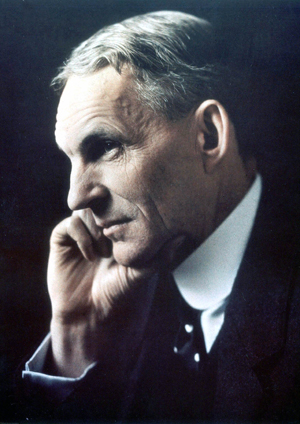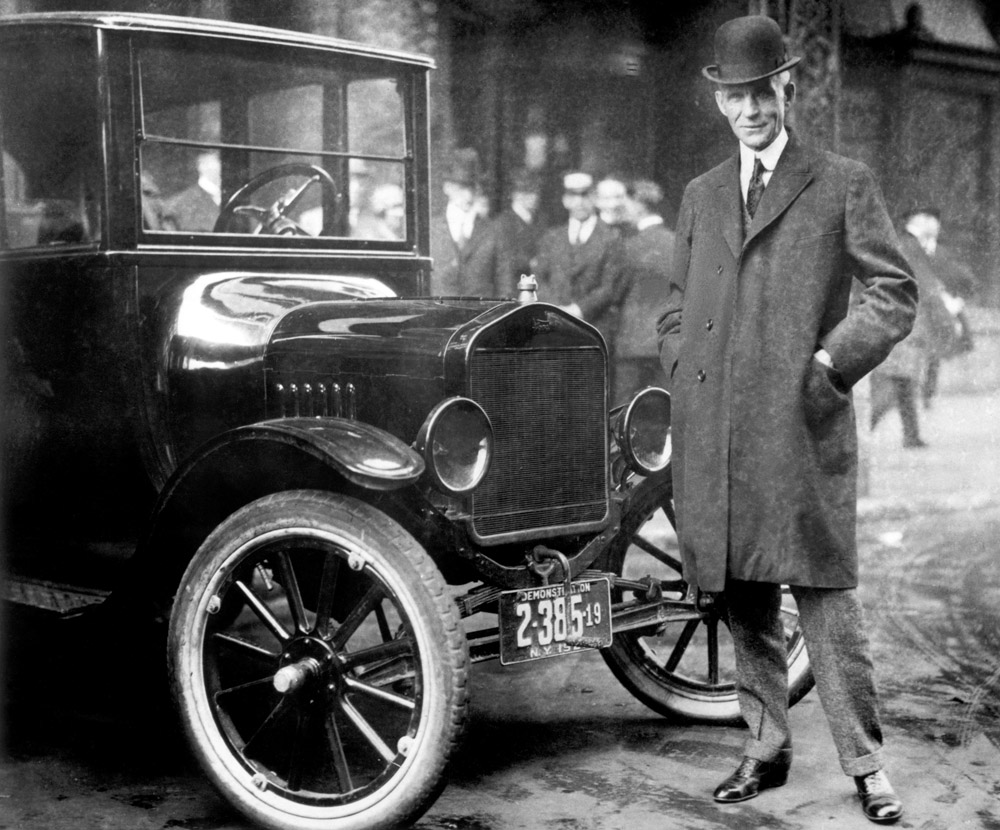 Henry Ford, founder of Ford Motor Company, was born in Dearbornville, Springfield Township, Wayne County, Mich., on July 30, 1863. His parents were William and Mary (Litogot) Ford. He was the eldest of six children – four boys and two girls. His father was a native of Kilmalooda Parish, County Cork, Ireland, who came to America in 1847 and settled on a farm in Wayne County.
Henry Ford, founder of Ford Motor Company, was born in Dearbornville, Springfield Township, Wayne County, Mich., on July 30, 1863. His parents were William and Mary (Litogot) Ford. He was the eldest of six children – four boys and two girls. His father was a native of Kilmalooda Parish, County Cork, Ireland, who came to America in 1847 and settled on a farm in Wayne County.
Young Henry Ford showed an early interest in mechanics. By the time he was 12, he was spending most of his spare time in a small machine area he had equipped. There, at 15, he constructed his first steam engine.
Later, he became a machinist’s apprentice in Detroit in the shops of James F. Flower and Bros. and in the plant of the Detroit Dry Dock Co. After completing his apprenticeship in 1882, he spent a year setting up and repairing Westinghouse steam engines in southern Michigan. In July, 1891, he was employed as an engineer by the Edison Illuminating Company of Detroit. He became chief engineer on Nov. 1, 1893.
On April 11, 1888, he married Clara J. Bryant of Greenfield, Mich., the daughter of Melvin Bryant, a Wayne County Farmer. They had one son, Edsel Bryant Ford, born Nov. 6, 1893.
Ford’s career as a builder of automobiles dated from the winter of 1893 when his interest in internal combustion engines led him to construct a small one-cylinder gasoline model. The first Ford engine sputtered its way to life on a wooden table in the kitchen of the Ford home at 58 Bagley Avenue in Detroit. A later version of that engine powered his first automobile – essentially a frame fitted with four bicycle wheels. That first Ford car was completed in June, 1896.
On Aug. 19, 1899, he resigned from the Edison Illuminating Company and, with others, organized the Detroit Automobile Company. The company unfortunately went into bankruptcy a year-and-a-half later.
Meanwhile, Henry Ford designed and built several racing cars. In one of them, he defeated Alexander Winton in a notable race on a track in Grosse Pointe, Mich., on Oct. 10, 1901. In another car, the famous 999 racer, he established a world record for the mile, covering the distance in 39.40 seconds on Jan. 12, 1904, on the winter ice of Lake St. Clair.
On June 16, 1903, Ford helped organize the Ford Motor Company, capitalized at $150,000. Henry Ford did not put any capital into the venture. The first car built by the company was sold July 15, 1903. Henry Ford owned 25.5 percent of the stock in the new organization. He became president and controlling owner in 1906. In 1919, Ford, his wife, Clara, and his son, Edsel, acquired the interest of all minority stockholders for $105,820,894, and became sole owners of the company. Henry Ford turned over the presidency to his son Edsel in 1919. Due to Edsel’s unexpected death at 49 years of age, Henry reclaimed the presidency in 1943.
In September, 1945, when he resigned the presidency for the second time, Henry Ford recommended that his eldest grandson, Henry Ford II, be elected to that position. The board of directors followed his recommendation.
In 1946, Ford was lauded at the Automotive Golden Jubilee for his contributions to the automotive industry. In July of the same year, 50,000 people cheered him at Ford Field in Dearborn at a giant 83rd birthday party. That same year, the American Petroleum Institute awarded him its first Gold Medal annual award for outstanding contributions to the welfare of humanity.
Ford was a member of the Society of Automotive Engineers, the Automobile Club of America and the Detroit Board of Commerce.
In collaboration with Samuel Crowther, he wrote “My Life and Work” (1922), “Today and Tomorrow” (1926) and “Moving Forward” (1930), which described the development of Ford Motor Company and outlined his industrial and social theories. He also published “Edison, as I Know Him” (1930) with the same collaborator.
Doctor of Engineering degrees were conferred on him by the University of Michigan and Michigan State College, and he received an honorary LL.D. from Colgate University.
Henry Ford died at his residence, Fair Lane in Dearborn, at 11:40 p.m. on Monday, April 7, 1947, following a cerebral hemorrhage. He was 83. At his bedside were Mrs. Ford and members of the household staff. At the time of his death, flooding on the Rouge River, which flows through the grounds at Fair Lane, had cut off electrical power. Old-fashioned kerosene lamps and candles were the only sources of light in the house, creating a scene similar to that of his birth in the same county many years earlier.
Funeral services were held from St. Paul’s Episcopal Cathedral in Detroit, and Mr. Ford was buried in the Ford family cemetery at St. Martha’s Episcopal Church in Detroit.
Mrs. Ford died on Sept. 29, 1950, at the age of 84.

Chronology of the Life of Henry Ford
1863: Born July 30 in Dearbornville, Springfield Township, Wayne County, Michigan
1876: Makes his own tools and repairs a broken watch after a farmhand explains to him its inner workings
1879: Leaves family farm for Detroit to work in machine shops. Leaves school with a sixth-grade education
1882: Runs steam engine on neighboring farm
1883 – 1884: Works two summers at Westinghouse demonstrating and repairing steam engines
1884: Takes a few courses at Goldsmith, Bryant & Stratton Business University in Detroit for his only formal business training
1888: Marries Clara Bryant of Greenfield Township and moves to 80-acre farm in what is today Dearborn
1891: Secures position as engineer with the Edison Illuminating Co.; returns to Detroit
1893: Edsel Bryant Ford, only child of Henry and Clara Ford, born Nov. 6
1893: Builds a one-cylinder engine
1896: Completes his first automobile, the Quadricycle, and drives it through the streets of Detroit
1896: Meets Thomas Edison, who encourages Ford to continue with his automotive pursuits
1899: Ends eight years of employment with the Edison Illuminating Company to devote full attention to the manufacture of automobiles. Made chief engineer and partner in the newly formed Detroit Automobile Company, which produced only a few cars
1901: Drives his first racecar, “Sweepstakes,” to victory
1901: Henry Ford Company organized with Ford as engineer. Ford resigns over dispute with bankers in 1902 and the company becomes the Cadillac Motor Car Co.
1902: With the help of his friends, Ford builds the “999” race car. With the famed Barney Oldfield at the wheel, “999” wins a 5-mile race, helping attract new backers for another automobile company
1903: Ford Motor Company is officially incorporated on June 16. Ford’s first Model A appears on the market in Detroit
1903: Ford Motor Company makes its first sale on July 15. Dr. E. Pfennig of Chicago buys a Model A for $850, paid in full, and two other buyers make deposits, giving the company a much-needed infusion of cash
1904: Production begins at Piquette Avenue in Detroit, Ford Motor Company’s first purpose-built factory
1906: The lightweight, inexpensive Model N is America’s best seller
1907: Develops an experimental tractor
1908: Ford begins manufacturing the famous Model T
1910: Begins operations at factory in Highland Park, Mich.
1911: Ford Motor Company wins a lawsuit invalidating the 1879 Selden patent, which had claimed rights to all vehicles powered by internal combustion engines
1913: Introduces first moving automobile assembly line at Highland Park
1914: Announces his plan to share the Ford Motor Company’s profits with workers, paying them $5.00 for an eight-hour day
1915: Founds Henry Ford Hospital
1915: The Oscar II, Ford’s “Peace Ship,” sets sail for Norway on a pacifist expedition to end World War I
1917: Begins construction of industrial facility on the Rouge River in Dearborn, Michigan
1917: Fordson tractor debuts
1918: Loses his bid for the U.S. Senate
1919: Edsel B. Ford, son of Henry Ford, is named president of Ford Motor Company
1921: Ford Motor Company dominates auto production with 55 percent of industry’s total output
1922: Ford Motor Company buys Lincoln
1924: Begins work on what would later become the charcoal briquette
1926: Focuses on air transportation and develops the Tri-Motor airplane
1927: Transfers final assembly line from Highland Park plant to the Rouge. Production of the Model T ends, and the Model A is introduced
1929: Dedicates his Edison Institute of Technology and Greenfield Village with a celebration of 50 years of the electric light
1932: Builds first V-8 Ford car
1936: Ford Foundation established
1937: “Battle of the Overpass” occurs between Ford security staff and United Auto Workers union organizers. As a result, the court orders Ford not to interfere with union activity
1941: Ford Motor Company signs a contract with UAW
1943: Edsel B. Ford dies at age 49. Henry Ford resumes presidency
1947: Henry Ford dies at age 83, at Fair Lane, his Dearborn home

You must be logged in to post a comment.